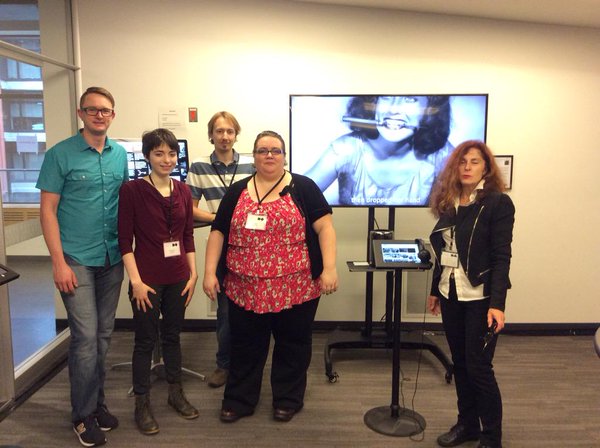“It’s all about challenging conventions . . . We must experiment with ways beyond objects” (Obrist, 148).
Electronic Literature and Its Emerging Forms enjoyed a large in-person audience and online presence, ultimately reaching over 4800 people during the reporting period (20 March 2013 through 12 April 2013). This exhibition showcased “27 works of electronic literature by American authors, relevant printed works from the Library of Congress collections, readings by select authors featured in the exhibit, and hands-on creation stations” (Electronic Literature and Its Emerging Forms).
These impressions however, should be considered as groundbreaking. Not only did the exhibit feature works of e-lit (pieces of art that are not traditionally viewed as art objects), but it also made an effort to contextualize and promote creativity and thought through the designated “Context” and “Creation” stations:
“We’ve designed the physical space to promote flow between literary and cultural ‘Contexts’ and ‘Creation Stations,’ where guests can ‘get their hands dirty’ making art using techniques from e-lit’s present and past” (Berens).
Such a layout is unconventional, experimenting with ways to better understand e-lit and its connections to older forms of art, while, at the same time, infusing the exhibit with further interaction and conversation. As Ulrich Obrist champions, it is advised, if not absolutely necessary, “to ‘complexify’ . . . and to introduce other viable models [of curation], experiment with other circuits . . . ‘routine is the enemy’” (146).
In a way, this “creation, production, realization, and promotion of ephemeral [exhibits]” also helps the act of conversation take place (Obrist, 167). The methodology of deliberately creating “Work,” “Context,” and “Creation” stations promotes an environment ripe for interaction and discussion, so much so that even curators Dene Grigar and Kathi Inman Berens write that they:
“believe the exhibit delivers an experience that the digital alone cannot convey, the serendipity of conversation among guests chief among these things” (Electronic Literature and Its Emerging Forms).
Throughout the experience, diverse visitors conversed with one another, building what Obrist calls “hundreds of pedestrian bridges to hundreds of communities who then converge and create new encounters” (169). With these moments of speech enmeshed throughout the typical viewing experience, visitors received a rich and inherently unique look at the exhibit, stumbling upon authors, teachers, enthusiasts, or others just passing by.
In all, this multi-layered experience — enhanced by creativity and historical context — ultimately developed a new curatorial methodology, delivering interactivity and community to a diverse body of individuals. It is clear that curators must take these ideas into account and further build upon them — doing so will attract, capture, and enlighten visitors, new and old.
